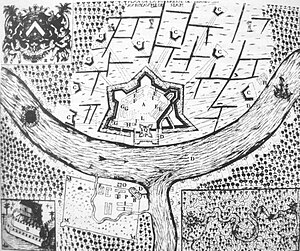Hong Kong began as a coastal
island geographically located in southern
China. While pockets of settlements had taken place in the Hong Kong region, with archaeological findings dating back thousands of years, regularly written records were not made until the engagement of
Imperial China and the British colony in the territory. Starting out as a fishing village, salt production site and trading ground,
[19] it would evolve into a military port of strategic importance and eventually an international financial centre that enjoys the world's 6th highest
GDP (PPP) per capita, supporting 33% of the foreign capital flows into China.
[20]
Pre-20th century

Hong Kong in the late nineteenth century was a major trading post of the
British Empire.
Human settlement in the area now known as Hong Kong dates back to the late Paleolithic and early Neolithic era,[21] but the name Hong Kong (香港) did not appear on written record until the Treaty of Nanking of 1842.[22] The area's earliest recorded European visitor was Jorge Álvares, a Portuguese explorer who arrived in 1513.[23][24]
In 1839 the refusal by Qing Dynasty authorities to import opium resulted in the First Opium War between China and Britain. Hong Kong Island became occupied by British forces in 1841, and was formally ceded to Britain under the Treaty of Nanking at the end of the war. The British established a crown colony with the founding of Victoria City the following year. In 1860, after China's defeat in the Second Opium War, the Kowloon Peninsula and Stonecutter's Island were ceded to Britain under the Convention of Peking. In 1898, under the terms of the Convention for the Extension of Hong Kong Territory, Britain obtained a 99-year lease of Lantau Island and the adjacent northern lands, which became known as the New Territories.[25] Hong Kong's territory has remained unchanged to the present.
20th century onwards
During the first half of the 20th century, Hong Kong was a free port, serving as an entrepôt of the British Empire. The British introduced an education system based on their own model, while the local Chinese population had little contact with the European community of wealthy tai-pans settled near Victoria Peak.[25]
In conjunction with its military campaign in the Second World War, the Empire of Japan invaded Hong Kong on 8 December 1941. The Battle of Hong Kong ended with British and Canadian defenders surrendering control of the colony to Japan on 25 December. During the Japanese occupation, civilians suffered widespread food shortages, rationing, and hyper-inflation due to forced exchange of currency for military notes. Hong Kong lost more than half of its population in the period between the invasion and Japan's surrender in 1945, when the United Kingdom resumed control of the colony.[26]
Hong Kong's population recovered quickly as a wave of migrants from China arrived for refuge from the ongoing Chinese Civil War. When the People's Republic of China was proclaimed in 1949, more migrants fled to Hong Kong in fear of persecution by the Communist Party.[25] Many corporations in Shanghai and Guangzhou also shifted their operations to Hong Kong.[25]
As textile and manufacturing industries grew with the help of population growth and low cost of labour, Hong Kong rapidly industrialised, with its economy becoming driven by exports, and living standards rising steadily.[27] The construction of Shek Kip Mei Estate in 1953 marked the beginning of the public housing estate programme, designed to cope with the huge influx of immigrants. Trade in Hong Kong accelerated even further when Shenzhen, immediately north of Hong Kong, became a special economic zone of the PRC, and established Hong Kong as the main source of foreign investment to China.[28] With the development of the manufacturing industry in southern China beginning in the early 1980s, Hong Kong's competitiveness in manufacturing declined and its economy began shifting toward a reliance on the service industry, which enjoyed high rates of growth in the 1980s and 1990s, and absorbed workers released from the manufacturing industry.[29]

 parliamentary democracy and a constitutional monarchy with Queen Elizabeth II as its head of state. It is a bilingual and multicultural country, with both English and French as official languages both at the federal level and in the province of New Brunswick. One of the world's highly developed countries, Canada has a diversified economy that is reliant upon its abundant natural resources and upon trade—particularly with the United States, with which Canada has had a long and complex relationship. It is a member of the G8, G-20, NATO, OECD, WTO, Commonwealth, Francophonie, OAS, APEC, and UN.
parliamentary democracy and a constitutional monarchy with Queen Elizabeth II as its head of state. It is a bilingual and multicultural country, with both English and French as official languages both at the federal level and in the province of New Brunswick. One of the world's highly developed countries, Canada has a diversified economy that is reliant upon its abundant natural resources and upon trade—particularly with the United States, with which Canada has had a long and complex relationship. It is a member of the G8, G-20, NATO, OECD, WTO, Commonwealth, Francophonie, OAS, APEC, and UN.








